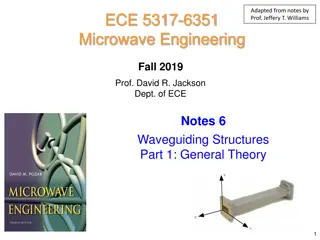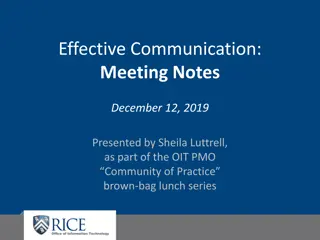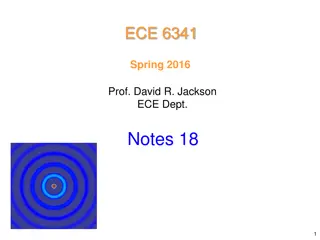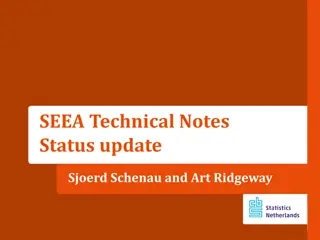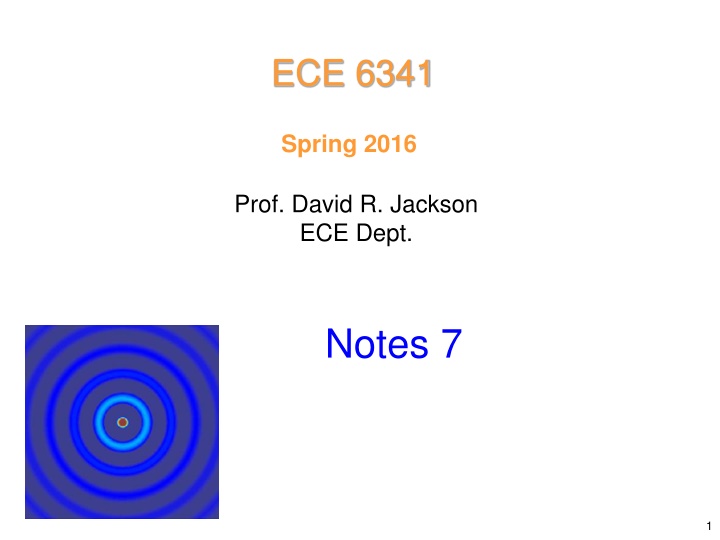
Analysis of Two-Layer Stripline and Parallel-Plate Waveguide Structures
Explore the derivation of transcendental equations for TMx modes of propagation in a two-layer stripline structure and a parallel-plate waveguide. Understand impedance considerations and wavenumber relations for different modes of propagation.
Download Presentation

Please find below an Image/Link to download the presentation.
The content on the website is provided AS IS for your information and personal use only. It may not be sold, licensed, or shared on other websites without obtaining consent from the author. If you encounter any issues during the download, it is possible that the publisher has removed the file from their server.
You are allowed to download the files provided on this website for personal or commercial use, subject to the condition that they are used lawfully. All files are the property of their respective owners.
The content on the website is provided AS IS for your information and personal use only. It may not be sold, licensed, or shared on other websites without obtaining consent from the author.
E N D
Presentation Transcript
ECE 6341 Spring 2016 Prof. David R. Jackson ECE Dept. Notes 7 1
Two-Layer Stripline Structure x , h2 2 2 r r , h1 1 1 r r z Goal: Derive a transcendental equation for the wavenumber kzof theTMx modes of propagation. Assumption: There is no variation of the fields in the y direction, and propagation is along the z direction. 2
Two-Layer Stripline Structure (cont.) R TEN: Z01 Z02 x h2 h1 TMx impedances: Note: Because this is a lossless closed structure, kz is either real (above cutoff) or imaginary (below cutoff). xk xk = = 2 1 Z Z 02 01 2 1 ( ) ( ) 1/2 1/2 = 2 2 2 z k k k = 2 2 z k k k 2 x 1 1 x = Z Z Transverse Resonance Equation (TRE): in in 3
Two-Layer Stripline Structure (cont.) Z Z in in Z02 Z01 x h1 h2 ( ) ( ) = tan Z jZ 1 1 x k h = tan Z jZ k h 01 in 02 2 2 in x ( ) ( ) = tan tan Z 1 1 x k h Z k h TRE: 01 02 2 2 x or k k ( ) ( ) = tan tan 1 2 x x 1 1 x k h k h 2 2 x 1 2 4
TEN (cont.) Hence ( ) ( ) = tan tan k 1 1 x k h k k h 2 1 1 2 2 2 r x r x x Assuming nonmagnetic materials, ( ) ( ) 1/2 1/2 = 2 0 2 z k k k = 2 0 2 z k k k 2 2 x r 1 1 x r A similar analysis could be applied for the TEx modes. 5
Parallel-Plate Waveguide Special case: parallel-plate waveguide x = + h h h 1 2 , h r r z = = k k k 1 2 x x x 6
Parallel-Plate Waveguide (cont.) ( ) ( ) = tan tan k k h k k h 1 2 r x x r x x or ( ) ( ) + = tan tan 0 k h k h 1 2 x x Helpful identity: + tan( ) 1 tan( )tan( ) a tan( ) a b b ( ) a b + = tan We then have ( ) ( ) ( ) + 1 tan = tan tan 0 k h k h k h k h 1 2 1 2 x x x x This will be satisfied if ( ) + = tan 0 k h k h 1 2 x x 7
Parallel-Plate Waveguide (cont.) Hence we have ( ) xk h = tan 0 so = = , 0,1,2 xk h m m We have (from the separation equation) = 2 0 2 x k k k z r Note: TMx and TEx modes have the same wavenumber, but only the TMx mode can exist for m = 0. (the electric field is perpendicular to the metal walls). Hence 2 m = 2 0 k k z r h 8
Waveguide With Slab y TExmn modes TMxmn modes b x w a ( ) / 2 = L a w TEN : w L L Z Z Z 01 00 00 9
Waveguide With Slab (cont.) k = TM = TE 0 x Z 0 Z 00 00 k 0 0 x k = TM = TE 1 x Z Z 1 01 01 k 1 1 x Wavenumbers: Note: n y b n y b 1/2 ( ) 2 = jk z sin A F x e n z = 2 0 2 z x k k k 0 x b ( ) = jk z cos F G x e z 1/2 2 x n = 2 0 2 z k k k 1 x r b Note: In the BCs, Ax acts like Ex while Fx acts like Hx. 10
Waveguide With Slab (cont.) First try reference plane at x = 0: = Z Z = 0 Z R Z Z Z Z 01 00 00 x 11
Waveguide With Slab (cont.) Z (1) in (2) in Z Z Z Z Z 01 00 00 w L L x + + tan tan Z Z jZ jZ l l = 0 L Z Z General formula: 0 in 0 L = (1) in tan( ) Z jZ k L 00 0 x Apply this twice: + (1) in tan( tan( ) ) Z Z jZ jZ k w k w = (2) in 01 (1) in 1 x Z Z 01 + 01 1 x 12
Waveguide With Slab (cont.) Z (1) in (2) in Z Z Z Z Z 01 00 00 w L L x Apply again: ( ) 2 in + tan( tan( ) ) Z Z jZ jZ k L k L = 00 0 x Z Z ( ) 2 in 00 + 00 0 x A mess ! 13
Waveguide With Slab (cont.) Now try a reference plane at the center of the structure (the origin is now re-defined here). R w L L x Z01 Z00 Z00 Z Z TRE: = Z Z = 0 Z Hence (This is the only finite number that will work.) But (from symmetry): = Z Z 14
Waveguide With Slab (cont.) Now use an admittance formulation w L L Z01 x Z00 Z00 Y Y TRE: = 0 Y Hence = Y Y (only finite number that will work) But (from symmetry): = = Z Hence Y Y 15
Waveguide With Slab (cont.) 0 Hence, there are two valid solutions: = Z = 0 Z PEC wall = Z PMC wall PEC wall PMC wall 16
Waveguide With Slab (cont.) From symmetry: ( ) ( ) x = E x AE z z Even mode: A = +1 Odd mode: A = -1 z E x = 0 z E = 0 Plots of Ez Odd mode: PEC wall Even mode: PMC wall 17
Waveguide With Slab (cont.) H n E n = = = PEC: 0, 0, 0 t E H PEC wall: odd mode t n = = = PMC wall: even mode PMC: 0, 0, 0 t H E t n Note: even/odd is classification is based on the Ez field. z E x = 0 z E = 0 Plots of Ez Odd mode: PEC wall Even mode: PMC wall 18
Example: TEx Even Modes Z = Z ( ) 1 in Z R w + (1) in tan Z jZ k 01 1 x 2 w = Z Z Z Z Z 01 00 01 00 + (1) in tan Z jZ k 01 1 x 2 w L L Set w + = (1) in tan 0 Z jZ k 01 1 x 2 w + = tan( ) tan 0 Z j jZ k L k 01 00 0 1 x x 2 w = tan( )tan 0 Z Z k L k 01 00 0 1 x x 2 19
TEx Even Modes (cont.) w ( ) = tan tan 0 0 0 k L k 0 1 x x 2 k k 1 0 x x or w = tan( )tan 0 k k k L k 0 1 0 1 x x x x 2 TEx even 1/2 1/2 2 2 n n where = = 2 2 z 2 2 z k k k k k k 0 0 1 0 x x r b b Hence, the transcendental equation is in the form = ( ) F k 0 z 20
Four Possible Cases (We have only done one of them: TEx even.) TEx even TMx even TMx odd TEx odd 21
Cutoff Frequency (TEx Even) zk = 0 (closed structure) Set Then 1 2 1 2 2 2 n n = = 2 0 2 z 2 0 2 z k k k k k k 0 1 x x r b b Hence, the transcendental equation is now in the form = ( ) F k 0 0 = = cutoff frequency 2 k f f 0 0 0 c where c 22
LSE/LSM Terminology y This terminology is often used in the microwave community. x LSE: Longitudinal Section Electric . This means the same thing as TEx. The electric field vector of the mode has no x component, and hence it lies within the yz plane (This is called the longitudinal plane, which means the plane parallel to the slab face. LSM: Longitudinal Section Magnetic . This means the same thing as TMx. The magnetic field vector of the mode has no x component, and hence it lies within the yz plane (the longitudinal plane). 23






